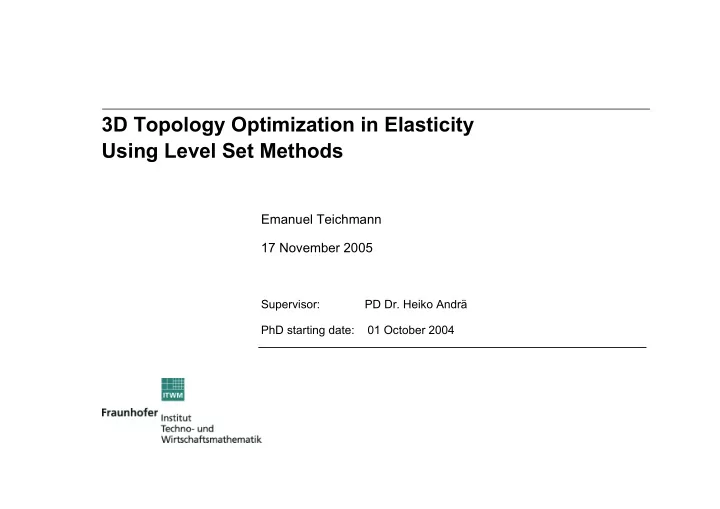

3D Topology Optimization in Elasticity Using Level Set Methods Emanuel Teichmann 17 November 2005 Supervisor: PD Dr. Heiko Andrä PhD starting date: 01 October 2004
Motivation Method of steepest descent using topological gradient min. compliance Topology Optimization: Find an optimal material distribution within a given design space s.t. prescribed constraints (volume, maximal stress, etc.) are not violated. J( Ω , u) → min such that a(u, v) = f(v) ∀ v ∈ V, ¦V¦ ≤ const. Level Set Method: Represent boundary as - + + + + zero level set of a function - - - + φ : Ω DS → ℝ page 2
Algorithm: Topology Optimization using Level Set Initial guess Initialization of mesh + BCs Level Set Fct (LS) Computation no Structural Update Convergence? of criterion for LS update analysis of LS (topol. gradient) yes Stop Automated Contouring: Update of BCs volume mesh surface mesh generation from LS Advantages: • Remeshing: adaptive discretisation for structural analysis • Complete FE model in each iteration (needed for simulation of casting process) Disadvantages: • Remeshing: costly, stability? • Interpolation errors in update of BCs page 3
Benefits from the Special Radon Semester Computation Structural Update of criterion for LS update analysis of LS (topol. gradient) • Crucial point: structural analysis. Introduction of an error • Influence of this error on the topological gradient and the update of the level set function? ⇒ ERROR ESTIMATION is the basis for investigation of precision of level set update page 4
Recommend
More recommend